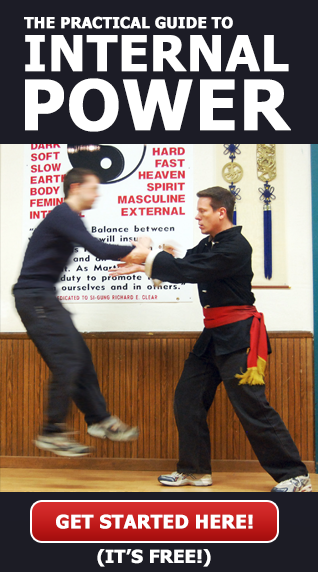What is Internal Kung Fu? Lets start by defining Kung Fu. The word Kung translates as work and the word Fu translates as Skill so Kung Fu directly translastes as Work Skill or Skillful Work. In Chinese culture (and indeed in any culture where craftsmanship is valued including our own culture) it is understood that for most folks to perform skilled work requires time for the individual to develop the skill. So, often you will see Kung Fu defined as skilled work acquired through hard work, time and practice. This leaves the word internal. Internal literally means inside. In this case inside means inside the body. So, Internal Kung Fu refers to skilled work inside the body.
Internal Kung Fu often refers to Tai Chi, Ba Gua and Hsing-I styles of Kung Fu but can also refer to Chi Kung / Qi Gong and other internal styles such as Liu Ho Ba Fa (6 Harmonies 8 Methods style), Ba Chi Chuan (8 Extremes Boxing) and many other lessor known styles of Kung Fu. Drunken style and monkey style are not normally classified as Internal Kung Fu but these styles are as much or more about internal development practice than they are external practice particularly in the case of Drunken style Kung Fu.
Internal styles are classified as Internal Kung Fu because they work on the internal work skill as much or more than any other aspect of practice. Internal Kung Fu styles empasize breath, posture, internal structural alignment, relaxation, mind intent and focus, chi development and energetic expressions.
An art does not have to be Chinese to be Internal and to have work skill. There are internal styles in many cultures and from many different countries that also take many years of hard work and practice to master.
One of the basic Internal Kung Fu ideas is to be able to transfer whole body power through a touch or a hit. This is much different than the normal slinging of the arms or fist (and kicks) that you see with most pugilistic arts. A quality internal stylist can receive a hit and transmit the force of the strike into the ground thereby dissipating it or can cause all of the force to immediately go back to the attacker either causing the attacker to be popped up into the air and flung away or can cause the force of the hit to go back to a specific spot in the attacker such as into their elbow thereby causing an immediate broken elbow. The ability to receive incoming force and to direct or redirect it like this is the work skill from the inside of the body that most serious internal stylists are referring to when they say Internal Kung Fu.
All of the Nei Kung Skills are Internal Kung Fu training methods as well. Many of the methods are for health but there is a very strong physical self defense skill that comes along with the development of this kind of internal power. So, health and self defense are developed at the same time. To see more about these skills please refer to my posts on Nei Kung.

Very informative post. Thank you for sharing your knowledge.
At age 43 (male) I recently became interested in learning T’ai Chi. Haven’t started yet. After reading your post, I wonder if I should start with Tai Chi, or instead with one of the other “internal Kung Fu” versions you mention.
Any input?
I would recommend starting with the Tai Chi unless self defense is your #1 priority. In that case the Kuntao Silat program will get you there a little faster.
Which of the five big animal styles would you say is the most internal?
Most of the animals are internal but focus on different aspects of internal.
So, it depends on what you are calling internal. If you will define what you mean by internal I can tell you which animal or animals best exemplify that.
🙂